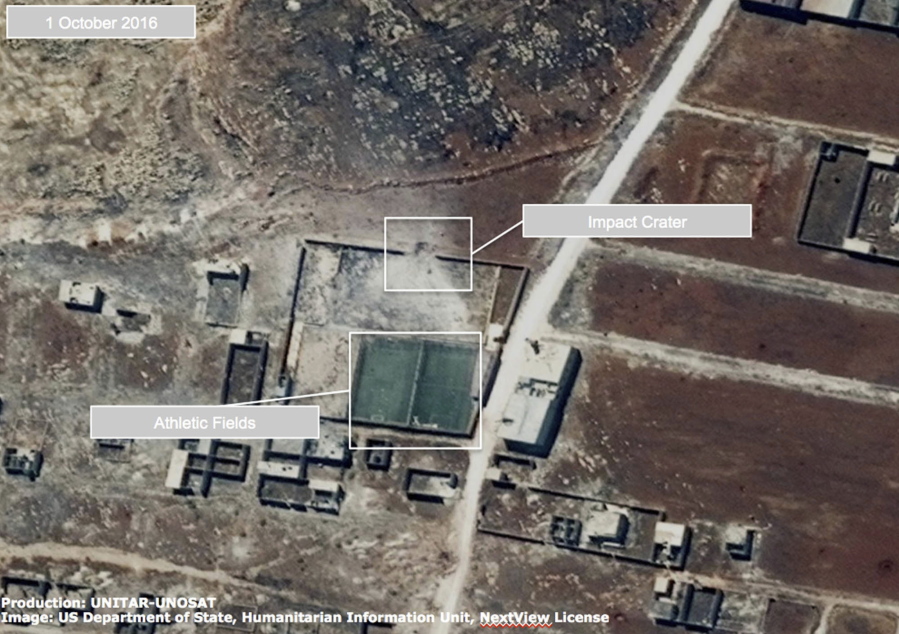GENEVA — The U.N. on Wednesday released stark satellite images showing the most recent destruction of Syria’s embattled northern city of Aleppo, which has been pounded by Syrian and Russian airstrikes since the collapse of a U.S.-Russia brokered cease-fire two weeks ago.
The release coincided with a stepped-up offensive by Syrian government forces and their allies attacking the city from the south in a bid to penetrate opposition-controlled areas, where the U.N. estimates 275,000 people are trapped in a government siege.
In Geneva, an official with the U.N.’s satellite imagery program said the new pictures from the rebel-held areas in the eastern half of the city show much destruction, presumably caused by airstrikes. U.N. and advocacy groups say hundreds of civilians, including at least 100 children, have died in the recent violence.
“Since the cease-fire has broken down, you certainly see an awful lot of new damage,” said Lars Bromley, a research adviser at UNOSAT.
The images, from DigitalGlobe and obtained by the U.N. agency through a licensing arrangement with the U.S. State Department, show mostly “formerly blasted and blown-up areas” during Syria’s 5-1/2-year war “experiencing a great deal of additional damage,” said Bromley.
“To a certain extent you’re looking at rubble being pushed around,” he told reporters.
The images primarily consist of before-and-after pictures from mid to late September showing the destruction of buildings, including houses, after the short-lived cease-fire broke down. Several images are from northern Aleppo neighborhoods, where government forces have advanced against rebel fighters who are battling back.
Some of the images depict large craters, a “signature” that airstrikes have done the damage. Artillery or mortar fire creates a different pattern of destruction, Bromley said.
Russia, which started an air campaign in support of President Bashar Assad’s government a year ago, says its goal in Syria is to fight militant groups such as Nusra Front, a U.N.-designated terrorist group that recently re-branded itself as Fatah al-Sham Front and claims to have cut ties with al-Qaida.
In a BBC interview last week, Russian Foreign Minister Sergey Lavrov said that 50 percent of the opposition in Aleppo were from Nusra Front, “as confirmed by the United Nations,” according to a transcript posted on Russian diplomatic websites.
Lavrov appeared to be referring to remarks by the U.N. envoy for Syria, Staffan de Mistura, to the U.N. Security Council on Sept. 25, who cited “information” from unspecified sources “that tell us that more than half of fighters present in eastern Aleppo are al-Nusra.”
Western diplomats and Syria’s main opposition say that no more than about 10 percent of fighters in Aleppo are from the Nusra Front.
The U.N. satellite images could provide significant insights in the aftermath of high-profile, disputed attacks — such as a deadly attack on a U.N.-backed humanitarian aid convoy west of Aleppo last month.
The top U.S. military officer, Marine Gen. Joseph Dunford, told a Senate committee last week that he believes Russia bombed the convoy and said Syrian and Russian aircraft were in the area at the time. Russia and Syria have denied that they were responsible for the strike, with Russia saying the damage was caused by a cargo fire.
“With our analysis, we determined that it was an airstrike,” Bromley said.
U.N. Secretary-General Ban Ki-moon said last week he would set up an internal U.N. board of inquiry to investigate the Sept. 19 incident involving a United Nations-Syrian Arab Red Crescent relief operation to Urum al-Kubra, west of Aleppo. U.N. officials had previously stopped short of declaring the attack an airstrike.
The convoy organizers had obtained necessary clearances from the government and rebels as well as the Americans and Russians, who were operating aircraft in Syrian skies.
The U.N. officials also presented images from Iraq that showed plumes of black smoke from burning oil fields about 15 kilometers (9 miles) south of Mosul that were set aflame as the Islamic State group retreated to the city. UNOSAT generally provides images to U.N. agencies, such as the refugee agency UNHCR, which is preparing for an expected exodus from IS-held Mosul after Iraq’s government announced plans to retake the city by the end of this year.
Also on Wednesday, a Syria monitoring group and a Kurdish news agency said overnight airstrikes, suspected to be Turkish, hit a village in northern Syria, killing at least 18 civilians, including three children.
The Britain-based Syrian Observatory for Human Rights said that at least 19 people were killed, including three children, in the attack on the majority Kurdish village of Thulthana, in northern Aleppo, several miles away from where Turkish-backed rebels have been advancing. The village is in an area controlled by IS militants.
The Hawar news agency in the semi-autonomous Kurdish areas of Syria said 18 were killed, among them six children. It said the attack happened around midnight Tuesday.
There was no immediate comment from Ankara. Earlier Wednesday, Turkish military officials reported it had pushed the Islamic State group out of four residential areas south of the town of al-Rai, several miles from Thulthana village. It said two Syrian opposition fighters, a Turkish soldier and 23 IS fighters were killed in the clashes.
Separately, a Turkish soldier was killed and three others were lightly wounded in fighting in the opposition-held area of Ziyara, which a group of IS militants tried to infiltrate.
The Turkish military launched an offensive inside Syria in August, backing Syrian rebels, to push Islamic State group militants from its borders and curb the advances of Syrian Kurdish forces, which it sees as an extension of its own outlawed Kurdish rebels.



